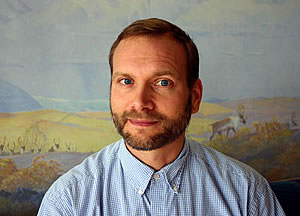Leading supercomputing center appoints chief scientist
Leading supercomputing center appoints chief scientist
Submitted by Debra Damron
Phone: (907) 450-8662
04/17/07
FOR IMMEDIATE RELEASE

Fairbanks, Alaska--Information transfer expert Greg Newby will oversee and lead scientific investigations that require the use of high performance computational resources as the newly appointed chief scientist at the Arctic Region Supercomputing Center.
ARSC, located on the University of Alaska Fairbanks campus, provides supercomputers, computational research, mass storage systems, visualization and high-speed networking to advance science, research and technology in several disciplines, ranging from geophysical phenomena of the Arctic to new breeds of high-performance software and microprocessors.
ARSC Director Frank Williams selected Newby for the position after a national search conducted earlier this year.
"One of the advantages to this hire is Greg’s ability to hit the ground running and his enthusiasm in promoting the resources at ARSC to the wider University of Alaska community,"? Williams said. ARSC is one of only 44 members of the national Coalition for Academic Scientific Computation.
Newby joined ARSC in 2003 as a research faculty member and was appointed acting chief scientist in 2005. His doctorate in information transfer is from Syracuse University. He previously was on the faculty of the University of North Carolina at Chapel Hill’s School of Information and Library Science, and before that, he was assistant professor at the University of Illinois at Urbana-Champaign’s Graduate School of Library and Information Science. At Urbana-Champaign, Newby also held an appointment as a senior research scientist at the National Center for Supercomputing Applications.
According to Newby, ARSC stands with other internationally known research institutes at the university, including the International Arctic Research Center, the Geophysical Institute, the Institute for Marine Science and the Institute for Northern Engineering, and is an integrated part of the campus community, employing 45 full-time staff members, 11 postdoctoral fellows, and 15 graduate and undergraduate students, and providing support to dozens of faculty members.
"And with the final acceptance testing of the new, 10-teraflop Sun supercomputer we’re calling Midnight, ARSC will further secure its position at the forefront of the nation’s university-based supercomputing centers,"? Newby said.
Newby also points to the number of ARSC computational scientists on campus in the areas of arctic systems modeling, remote sensing, regional weather forecasting, geophysics, ocean circulation and tsunami modeling as an added plus for serving both the university, the state and the nation.
ARSC provides high performance computational, visualization, networking and data storage resources for researchers within UA, other academic and scientific institutions, the Department of Defense, and other government agencies. As an allocated distributed center under the DoD’s High Performance Computing Modernization Program, ARSC has met or exceeded performance as measured by HPCMP metrics with unique, pioneering, open research systems for high-performance computing users.
Funded primarily by DoD through the HPCMP program, all computational research activities at ARSC are unclassified, with 70 percent of ARSC’s resources allocated for unclassified DoD use and 30 percent available for university and other national academic research.
CONTACT: Dr. Greg Newby, ARSC chief scientist at (907) 450-8600 or via e-mail at newby@arsc.edu. Debra Damron, UAF ARSC communications director, at (907) 450-8662 or via e-mail at damron@arsc.edu.


